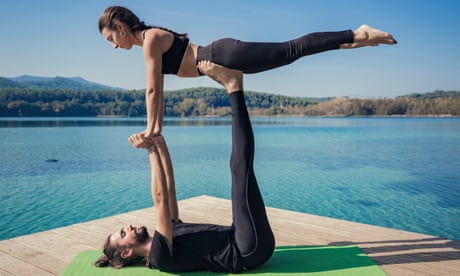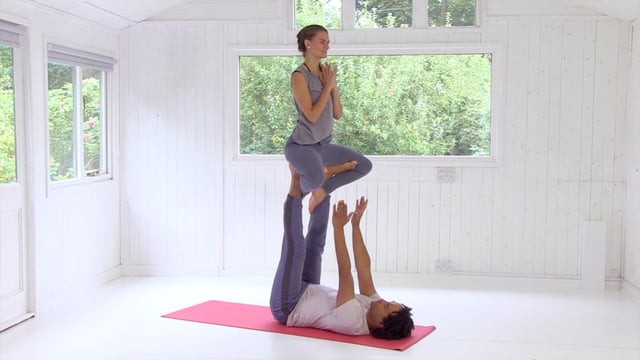Yoga is one of the most popular fitness routines that people of all ages are using to get into shape. Acro yoga, on the other hand, is a partnered or group subclass of yoga that allows for more acrobatic poses that are balanced on a partner. In acro-yoga, there are usually three roles observed: the flyer, the base, and the spotter.
The flyer is the participant who is balancing on the base and is usually off the ground. The base, unsurprisingly, is the participant who supports and lifts the flyer, giving them a solid base. The spotter watches the flyer and base and is ready to protect either the flyer or base if something were to go wrong.
If acro yoga is something that appeals to you, here are a few poses that you should implement in your next acro yoga sequence.
The “Front Plank”

One of the more basic acro poses, the front plank is the perfect pose to get a beginning flyer confident in their balance and trusting of their base. More importantly, the balance learned through mastering the front plank helps lay a strong foundation for more advanced poses and sequences.
This pose, like many others, begins with the flyer and base in a basic plank press pose. Once in the plank press, the flyer must reach forward, clasping their base’s hands. Make sure to keep your arms straight and in line with the base’s shoulders. Once you feel connected press your feet into the ground to lift off and lift off. It is important for the flyer to keep their core engaged, point their toes, and straighten the legs.
The base’s role in the front plank is to keep their arms straight as their flyer lifts off. Receive the flyer with bent knees and slowly straighten the legs, stacking the feet over the hips.
The “Front Bow”

The next pose to try out is the front bow pose. The front bow is more advanced than the front plank previously mentioned but works as a good transition between beginner and intermediate acro yoga poses. To reach this pose, the partners should be able to reach and hold the front bird pose.

From the bird pose, the flyer must use their back muscles engaged to lift the shoulders back and away from the ears. Reaching backwards, the flyer must grasp their feet and balance on their base. The base, on the other hand, should keep their core engaged with their feet, legs, and hips in line with their flyer’s.
Straddle Throne

To execute this pose, you must begin in the high-flying whale position. From this pose, the flyer needs to bend their knees 90 degrees and lift their hips up. The base will wrap their hands around the flyer’s feet. The flyer should slowly roll up with their chin to their chest as the base moves their foot, one by one, under the sitting bones. The flyer should shift their weight to one side as the base repositions their feet towards the hamstrings, allowing the flyer to wrap their legs around the base’s feet.
Back Bird

The back-bird pose is another sequence of beginner acro yoga and is a simple start to acrobatic flying. For this pose, the flyer should stand close towards their base’s feet. The flyer should grasp their base’s shins as they bend backwards onto their base’s bent knees. Once comfortable, the base should slowly straighten their legs and balance their flyer on their feet.
Chair Pose

The final must try pose on our list is the iconic chair pose. In this particular instance, the chair pose will be balanced on the base’s shins, instead of balancing on their feet. For this pose, the base should lay on their back with their knees over their hips. The flyer should place their big toe, one foot at a time, onto the base’s shin, underneath the knee. Once both feet are resting and the flyer feels balanced, lift up and into the chair pose. Once the flyer is standing, the base can stabilize their legs by grasping onto the outside of their thighs.
Hello, I’m Habib Ahmed mithu. I’m a Sydney Based Professional Blog Writer. My passion is writing articles in difference blog. I’m working on this section for 3 years
Post new comment
Please Register or Login to post new comment.